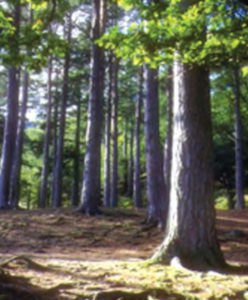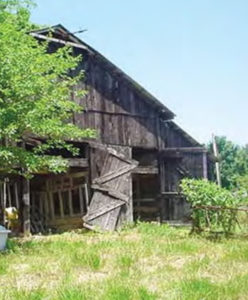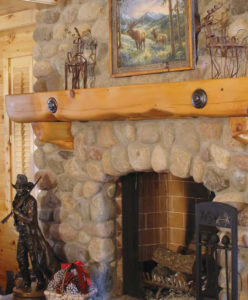Reclaimed lumber is wood that has been taken from long-standing idle buildings and refinished for new purposes. Most
reclaimed lumber comes from timbers and decking rescued from old barns, factories and warehouses and some companies
have been known to source wood from less traditional structures such as boxcars, coal mines, and wine barrels. Reclaimed
or antique lumber is used primarily for decoration and home building and is often used for siding, architectural details,
cabinetry, furniture and flooring.
Old Growth Wood Mantels are made from historic antique timbers that have now had “three lives”.
Life #1

Old Growth Pine Stand
Its first life was as an old-growth tree in a newly growing country that was then covered in majestic virgin forests.
Life #2

Merrill Farm Barn, Merrill, WI. Circa 1890
Its second life was as a timber in an historic structure built by hard hand labor in the nineteenth century.
Life #3

Family Room Mantel
Now, in its third life, your Old Growth Wood Mantel hangs above your fireplace, the heart of your home ... where it now belongs.
Wood Origins
In the United States, wood once functioned as the primary building material because it was strong, relatively inexpensive and abundant. Today many of these woods that were once plentiful are only available in large qualities through reclamation. One common reclaimed wood, longleaf pine, was used in factories and warehouses built during the Industrial Revolution. Longleaf heart pine was once the most functional wood for construction in America. It was slow-growing (taking 200 to 400 years to mature), tall, straight, and had a natural ability to resist mold and insects. More importantly, it was abundant. Longleaf yellow pine grew in thick forests that spanned over 140,000 square miles. Another previously common wood for building was the American Chestnut. Beginning in 1904, a chestnut blight spread across the US killing billions of American Chestnuts. Before the wood was destroyed, it was used to build barns and other structures, which preserved the wood for later reuse when these structures were later dismantled. Barns serve as one of the most common sources for reclaimed wood in the United States. Barns constructed up through the early part of the 19th century were typically built using whatever trees were right there on the property. They often contain a mixed blend of oak, chestnut and other woods including poplar, hickory and pine. Beam sizes were limited to what could be moved by man and horse. The wood was either hand hewn using an axe or squared with an adze. Early settlers also recognized the oak from its European subspecies. Soon red, white, black, scarlet, willow, post and pin oak varieties were being cut and transformed into barns too.
With a growing number of competitors, it is getting hard to find high quality used wood. With such a high demand,
some sellers try to pass newer wood off as antique. Reclaimed lumber is typically more expensive than new lumber
primarily due to expenses associated with dismantling, sorting, and preparing the wood.
Drawbacks to Reclaimed Lumber
Properties of Reclaimed Lumber
Reclaimed lumber is popular for many reasons: the wood’s unique appearance, its contribution to green building, the
history of the wood’s origins and the wood’s physical characteristics such as strength, stability and durability.[3] Reclaimed
beams can be sawn into wider planks than the harvested lumber and many companies purport that their products are more
stable than newly cut wood because reclaimed wood has been exposed to changes in humidity for far longer and therefore
more stable, allowing them to be used with radiant heating systems. In some cases, the timbers from which the boards
were cut have been slightly expanding and contracting for over a century in their previous installation. Radiant heat,
with its low temperatures and even distribution affects the wood flooring the same way, but the impact is much less
dramatic with antique wood than newly sawn wood because antique wood has already been through this cycle for years.
Reclaimed Lumber Industry
The reclaimed lumber industry gained momentum in the early 1980’s on the West Coast when large-scale reuse of
softwoods began. The industry grew due to a growing concern for environmental impact as well as declining quality in
new lumber.[4] On the East Coast, industry pioneers began selling reclaimed wood in the early 1970’s but the industry
stayed mostly small until the 1990’s as waste disposal increased and deconstruction became the more economically savvy
alternative to demolition.[5]
Reclaimed Lumber vs. Old Growth
Old Growth refers to established forests that, up until the time trees are cut, have had little or no disruption. Advocates
of cutting old growth timbers suggest that pruning selected trees is good for the forest. However, opponents believe that
growth forests maintain themselves through a natural process that does not include cutting into the delicate fabric woven
by nature. The actual age that determines “old” growth varies depending on the specie, but it refers to the age at which
a tree has reached its maturity. For an eastern white pine, it is between 130-150 years, while many of the hardwoods reach
maturity at 80 years. Virgin Growth refers to dense stands of various species of hardwood or pine trees that are indigenous
to their habitat; they have never been harvested. Many virgin forests are protected, but there are also many that are cut
for industrial purposes. Essentially, virgin timber is old growth that has never been cut, while old growth may or may not
be virgin timber. The difference between old growth timber and reclaimed or antique wood is that the reclaimed wood
was actually cut a hundred or more years before it is collected and reused. As with virgin growth, not all old growth is
actually considered “antique” or “reclaimed wood” but antique/reclaimed wood is typically old growth.
Reclaimed Lumber and LEED
The Leadership in Energy and Environmental Design (LEED) Green Building Rating System™ is the USGBC’s
benchmark for designing, building and operating green buildings. To become certified, projects must first meet the
prerequisites designated by the USGBC then earn a certain number of credits within the six categories: sustainable
sites, water efficiency, energy and atmosphere, materials & resources, indoor environmental quality, innovation &
design process. Using reclaimed wood can earn credits towards achieving LEED project certification. Because reclaimed
wood is considered recycled content, it meets the Materials & Resources criteria for LEED certification and because
some reclaimed lumber products are FSC certified, they can qualify for LEED credits under the “certified wood”
category.[6]